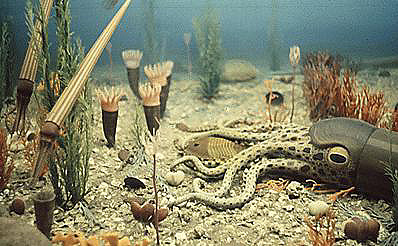The Ordovician Period was the second period of the Paleozoic Era. Ordovician rocks were first found in Wales, so its name comes from a tribe of Celts who once lived in the area where these sedimentary deposits were first identified. The Ordovician began about 490 million years ago and lasted for about 47 million years.
The modern continents of North America, Western Europe and Northern Europe were mostly located in the tropics, on or near the equator. These land areas were often covered by shallow seas though toward the end of the Ordovician Period more of these lands were out of the water due to changes in the Earth’s climate. During the first parts of the Ordovician the climate was fairly warm. When the Gondwana super-continent, now Asia, Africa, Australia and Antarctica, moved over the South Pole glaciers formed. This caused the sea level to drop and the climate to change leading to a mass extinction event that is used to define the end of the Ordovician Period.
There is evidence that the first primitive plants began to appear on the previously barren land but life was still primarily found underwater. These organisms secreted shells that settled out of the water column and were deposited on the ocean floor as pelagic ooze and eventually become the limestone and shale ‘mudstones’ associated with the Ordovician.
The seas of the Ordovician Period were full of many diverse species:

The Trilobites did not die out with the mass extinction at the end of the Cambrian period. Trilobites lived on and many new species developed.
The Cephalopods became the dominant predators of this period. Cephalopods are a group of mollusks that are related to octopus and squid but these sported shells, both straight and conical or a spiral shell like the modern nautilus.
Other invertebrates included Brachiopods , new in the Ordovician period, that look like modern clams, but they do not belong to the same family, Bryozoans and Crinoids or Sea Lily, an echinoderm that looked like a feathery plant and that still exists in today’s oceans.
Sponges, corals and even primitive fish also lived in Ordovician waters.
At the posted co-ordinates you will find flat-lying beds of ‘Ottawa Group’ limestone of the Verulam formation. Interbeds of carbonate mud show abundant trace fossils both perpendicular & parallel to the limestone beds. Shelly fossils include bryozoa, brachiopods, crinoids and orthocone cephalopods revealed as the limestone erodes away over time. The crinoid fossils, segments of the animals that in cross-section look like lifesaver candies embedded in the stone, or like segmented tubes if whole, are especially common. Though not a large area it has convenient parking and is accessible until the snow falls.
An even better fossil site is the ‘beach’ of exposed limestone beds at Parc Brébeuf across the river in Gatineau where, when then river level is low enough, there are large exposed fossil bryozoa colonies recognizable by their branching intertwined stick-like growths, as well as crinoids and some nice cephalopod fossils. A warning though, high water levels in the spring and early summer will make this site unavailable.
To log this find you must visit either of the two sites, locate two different fossils, submit photographs of yourself with the fossils, and a close-up with your GPSr in the shot for scale, with your ‘found’ log. See the sample photo. Then email me the name of the fossil type you believe it to be and tell me if it stood out from the surrounding stone or was flush with the surface and why that should be.
Help protect these fossils by observing and photographing only. Please restrict collecting to loose slabs, leaving in-place fossils and structures for others to enjoy. Check out construction site excavations in the local Billings Shale. These commonly provide fantastic pyritized trilobites and orthocones. You can also enjoy guided fossil hunts at the Bonnechere Museum just up the valley in Eganville.